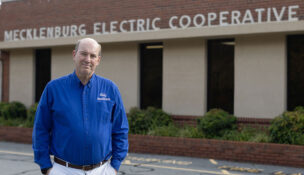SCC approves Dominion’s $9.8B offshore wind farm
176-turbine farm will be 27 miles off Va. Beach coast
SCC approves Dominion’s $9.8B offshore wind farm
176-turbine farm will be 27 miles off Va. Beach coast
The State Corporation Commission has approved Dominion Energy Inc.’s application for the proposed $9.8 billion Coastal Virginia Offshore Wind Project (CVOW), which calls for the construction of 176 wind turbines 27 miles off the coast of Virginia Beach.
The Richmond-based Fortune 500 utility has already erected two pilot turbines for its 2.6-gigawatt Coastal Virginia Offshore Wind (CVOW) project. Installation of the wind turbines is expected to begin in 2024. When completed in 2026, the CVOW project will be the nation’s largest offshore wind farm, powering up to 660,000 homes with renewable energy.
The SCC also approved the electric interconnection and transmission facilities to connect CVOW with the existing transmission system.
“Following a full proceeding, the commission found, as directed by the General Assembly, that construction of CVOW is in the public interest,” the SCC wrote in a news release announcing the approval.
It will likely be the largest capital investment and single largest project in the history of Dominion Energy Virginia, according to the SCC.
“Our customers expect reliable, affordable energy, and offshore wind is key for delivering on that mission. We are very pleased that the commission has approved this important project that will benefit our customers,” Dominion Energy Chairman, President and CEO Robert M. Blue, said in a statement. “We are reviewing the specifics of the order, particularly the performance requirement.”
$14 monthly electric bill hikes
With the approval of the wind farm, the SCC also approved a revenue requirement of $78.702 million for the rate year from Sept. 1, 2022, through Aug. 31, 2023, to be recovered through rate increases to Dominion’s customers.
“Over the projected 35-year lifetime of the project, for a residential customer using 1,000 kilowatt-hours of electricity per month … [it] is projected to result in an average monthly bill increase of $4.72 and a peak monthly bill increase of $14.22 in 2027. The rate adjustment clause is effective for usage on and after Sept. 1.”
However, the SCC wrote in its ruling: “In so finding that these costs must be recovered from customers, the commission is also keenly aware of the ongoing rise in gas prices, inflation and other economic pressures that are impacting all utility customers. This is a prescriptive statute, and we applied it based on the record in this case.”
The SCC ordered consumer protections, including that Dominion must file a notice within 30 days if the offshore wind farm’s cost is expected to exceed the current estimate or if the final turbine installation is delayed beyond Feb. 4, 2027. Dominion must also inform the SCC about any material changes to the project and says “customers shall be held harmless for any shortfall in energy production below an annual net capacity factor of 42% as measured on a three-year rolling average.”
“The final order from the SCC affirms that CVOW meets all Virginia statutory requirements for rider cost recovery and the issuance of a Certificate of Public Convenience and Necessity for the onshore infrastructure. The order also includes a performance requirement, but does not outline the details surrounding that requirement,” Dominion noted in a news release.
Harrison Godfrey, managing director of Virginia Advanced Energy Economy, an industry association that has supported Dominion’s proposal, applauded what it called the SCC’s attempts to protect ratepayers by requiring Dominion to provide notices if the wind farm’s total costs exceed estimates as well as requiring the utility to deliver project updates to the commission on any material changes or cost overruns.
Dominion submitted its application to the SCC in November 2021. The offshore wind farm had been previously estimated to cost $7.8 billion but that cost was increased by $2 billion late last year. Bob Blue, the Richmond-based Fortune 500 utility’s chair, president and CEO attributed the increase to rising commodities expenses and general cost pressures across a number of industries due to inflation. He also cited the need to build about 17 miles of new transmission lines and other associated infrastructure for the project.
East Coast supply chain hub
The project is expected to attract significant investments to Hampton Roads while spurring as many as 900 construction jobs and 1,100 jobs in operations and maintenance, Hampton Roads Alliance President and CEO Doug Smith told Virginia Business.
“This country is building an industry from scratch, that is the offshore wind industry,” Smith said. “Dominion’s project represents an opportunity for Virginia, and candidly, Hampton Roads, in particular, to be on the forefront of that new industry. What that will allow us to do is to begin to build the supply chain hub for the East Coast and build upon the strengths of a very skilled workforce and maritime industrial base that very few other regions have.”
Virginia Advanced Energy Economy has estimated that the offshore wind industry will add 5,000 jobs to the commonwealth over time.
Hampton Roads, already home to skilled shipbuilders who build and maintain naval ships across its various shipyards, including Huntington Ingalls Industries’ Newport News Shipbuilding division, has been preparing for the needs of an offshore wind workforce. Earlier this year, the Hampton Roads Workforce Council launched its Hampton Roads Strong campaign in partnership with local community colleges and the Virginia Ship Repair Association to recruit workers to the maritime trade, skills that are transferable to the needs of offshore wind, said the workforce council’s president and CEO, Shawn Avery.
News of the SCC’s approval also comes a day after the U.S. Department of Commerce announced it was granting $11 million to the workforce council to invest in workforce development.
“This grant couldn’t come at a better time to help develop the workforce,” Avery told Virginia Business Friday. “What it’s really going to do is increase the capacity to put training in place. It’s got a lot of funding in it for recruitment of individuals. … It’s really developing a system that’s going to meet the needs of the offshore wind industry and the shipbuilding/ship repair industry and anything else we need to happen.”
Though construction of the wind farm isn’t expected to begin until 2024, Siemens Gamesa Renewable Energy S.A., a Spanish wind turbine company, is already investing $200 million to build the first U.S. offshore wind turbine blade manufacturing facility at the Port of Virginia’s Portsmouth Marine Terminal. Siemens Gamesa will make 176 14.7-megawatt turbines to be installed in the Dominion wind farm’s 112,800-acre commercial lease area. Construction of the factory is expected to be complete in early 2023, bringing with it 310 jobs.
Reaching net-zero
The CVOW will help Virginia reach its target, codified in the Virginia Clean Economy Act (VCEA), of having 100% carbon-free energy production by 2045, and Dominion Energy’s goal of reaching net-zero carbon and methane emissions by 2050. President Joe Biden’s administration has set a 2030 target to establish 30,000 megawatts of offshore wind power capacity.
The VCEA mandates that all electricity consumed in the commonwealth must have zero carbon emissions and be generated from renewable energy sources by 2050. It also requires stringent energy-efficiency standards that are projected to generate as much as $3,500 in savings for the average Virginia household over the next 30 years, according to a study by Advanced Energy Economy, an industry trade association.
Although Republicans wield more power in Richmond this year and have expressed dissatisfaction with the VCEA, utilities do not expect significant changes to the law.
r
















